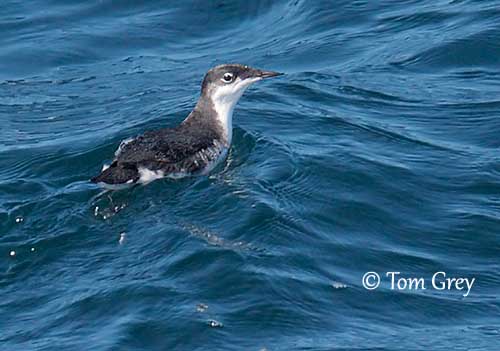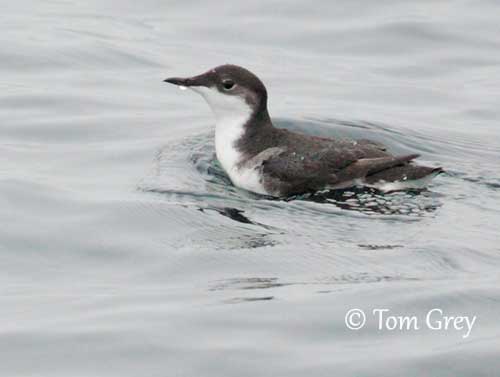
Fr: Guillemot de Scripps
Ang: Scripps’s Murrelet
All: Scrippsalk
Esp: Mérgulo californiano aliclaro
Ita: Urietta di Scripps
Nd: Scripps' Alk
Sd: Scripps californiaalka
Photographer:
Tom Grey
Tom Grey's Bird Pictures & Tom Grey's Bird Pictures 2
Text by Nicole Bouglouan
Sources:
HANDBOOK OF THE BIRDS OF THE WORLD Vol 3 by Josep del Hoyo-Andrew Elliott-Jordi Sargatal - Lynx Edicions - ISBN: 8487334202
FIELD GUIDE TO THE BIRDS OF NORTH AMERICA - National Geographic Society - ISBN: 0792274512
National Park Service – Channel Islands
The Birds of North America Online
What Bird-The ultimate Bird Guide (Mitchell Waite)
Wikipedia, the free encyclopaedia
Status, Distribution, and Conservation of Scripps's Murrelet at Santa Catalina Island, California
Scripps’s Murrelet
Synthliboramphus scrippsi
Charadriiformes Order – Alcidae Family
INTRODUCTION:
The Scripps’s Murrelet was formerly a subspecies of the Xantus’s Murrelet, alongside the Guadalupe Murrelet. Both are now considered full species. They occur along the coasts of California, one in North and the second in South.
These species differ by facial pattern and bill shape, vocalizations and genetics.
The Scripps’s Murrelet is threatened by introduced mammals at breeding colonies, and the global climate change could have a negative impact on food availability.
The species is currently listed as Vulnerable.
DESCRIPTION OF THE BIRD:
Biometrics:
Length: 23-25 cm
Wingspan: 41 cm
Weight: 135-215 g
The Scripps’s Murrelet is a small seabird slightly smaller than an American Robin.
The adult has black upperparts with blue-grey wash in fresh plumage, but mostly dull brown in worn plumage. Some dark feathers may sometimes form a partial collar on neck sides.
The underparts are white including chin, throat, underwing-coverts and undertail coverts. The flanks are sometimes mottled grey and white.
On the black head, we can see more or less distinct white eye-crescents above and below the eye.
The short bill is blackish. The eyes are dark brown. Legs and webbed feet are bluish-grey.
Male and female are similar. Both adults are paler in winter, mostly greyish-black above.
The juvenile resembles adult, but the flanks show scattered dark bars.

RANGE:
The Scripps’s Murrelet breeds on S Californian Channel Islands, and on islands off the W coast of Baja California.
It winters offshore N along the Pacific coasts to N California and S British Colombia, and S to extreme S of Baja California.
HABITAT:
The Scripps’s Murrelet nests on rocky slopes and steep cliffs on islands, usually under bushes, shrubby and herbaceous plants.
Outside the breeding season, it occurs offshore from the breeding colonies in the warm pelagic waters of the California Current. It usually avoids the colder coastal waters. It may go well offshore, beyond the continental shelf.
CALLS AND SONGS: SOUNDS BY XENO-CANTO
The Scripps’s Murrelet gives a loud, rapid call of 6-8 regularly spaced “seep” notes on the same pitch, fairly similar to the piping whistle of Pigeon Guillemot. It calls often at night at breeding colonies. It also utters “chip” notes and whistles. The sounds produced inside the nesting cavity or crevice are softer, and also given while feeding. Calling starts at dusk and continue into the morning, 2-3 hours after sunrise, with nocturnal chorus in the middle of the night.
BEHAVIOUR IN THE WILD:
The diet of the Scripps’s Murrelet is poorly known, but it probably feeds on small prey such as larval fish, small crustaceans and marine invertebrates. The prey include sandheels, anchovies, rockfish and euphausiids, mainly taken during the breeding season.
Outside this period, it feeds in warmer waters often associated with large pelagic predatory fish like tuna.
The Scripps’s Murrelet forages by diving and swimming underwater, propelled by the wings. It may forage in pairs or in family groups, depending on the season.
They breed on small islands and in small colonies. They are monogamous with long-term pair-bonds. They return to the same nesting site in several following years. As usual, they have nocturnal habits at colonies. They nest in rock crevices and caves under dense cover.
The Scripps’s Murrelet performs post-breeding dispersal, largely offshore to W and to N. They can be seen in small family groups, usually pairs accompanied by their flightless chicks swimming on water.
They arrive off Californian coast in July/August to spend the winter, and remain until late November/early December. Some of them winter N to British Colombia. They return to the breeding grounds between November and January.
The Scripps’s Murrelet has swift direct flight with rapid wingbeats.
REPRODUCTION OF THIS SPECIES:
The Scripps’s Murrelet usually arrives three weeks before the laying, at mid-February. The laying takes place from late February to mid-June, with peak in late March/mid-April.
It breeds at low densities in small colonies established in cliffs on islands. It nests in caves, rock crevices or abandoned burrows and shrubs. It may lay on the ground under dense vegetation on maritime sandy slopes. There is no nest built.
The female lays two white or pale grey to brown eggs with dark markings, at 5/12 days intervals. Both adults share the incubation during 34 days, with stints of 3 days in average. At hatching, the chicks have black down above and white below, and they have large feet. Parents do not feed them before the departure. The chicks are precocial and leave the nest 1-2 days after hatching, with their parents. They leave at night and reach the sea, and the family swims away from the colony. The chicks are fed at sea by both adults during a long period.
The breeding success depends largely on anchovy availability.
PROTECTION / THREATS / STATUS:
The Scripps’s Murrelet is threatened by invasive, introduced mammals which are responsible for colony extinctions. Experimental control of deer mice has been attempted since the early 2000s.
The Californian breeding colonies are now in protected areas, but at sea, oil-spills and fishing nets could cause disturbance and mortality. Changes in sea temperature and global climate change could reduce the food resources in the future.
The global population is estimated at 15,000/30,000 individuals and is still declining.
The Scripps’s Murrelet is currently listed as Vulnerable.
